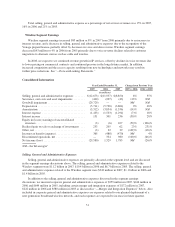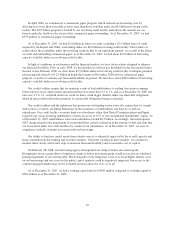Sprint - Nextel 2007 Annual Report Download - page 58
Download and view the complete annual report
Please find page 58 of the 2007 Sprint - Nextel annual report below. You can navigate through the pages in the report by either clicking on the pages listed below, or by using the keyword search tool below to find specific information within the annual report.accumulated depreciation accounts. The reduced expense associated with the depreciation rate changes resulted
in approximately $400 million reduction in depreciation expense or $0.09 per share reduction in net loss for the
year ended December 31, 2007. In addition to performing our annual study, we also continue to assess the
estimated useful life of the iDEN network assets, which had a net carrying value of $7.9 billion as of
December 31, 2007, and our future strategic plans for this network, as an increasingly larger portion of our
subscriber base is served by our CDMA network. A reduction in our estimate of the useful life of the iDEN
network assets would cause increased depreciation charges in future periods that could be material. For example,
a 10% reduction in the remaining weighted average useful life of the iDEN network assets would increase annual
depreciation expense by about $170 million. In conjunction with our fourth quarter goodwill impairment review,
we re-assessed the remaining useful lives of our long-lived assets and concluded they were appropriate. We are
in the process of completing our annual depreciation study and expect any results from that study to be concluded
and initially recorded in the first quarter 2008.
Intangible assets with definite useful lives represented $6.0 billion of our $64.1 billion in total assets as of
December 31, 2007. Definite lived intangible assets consist primarily of customer relationships that are
amortized over two to five years using the sum of the years’ digits method, which we believe best reflects the
estimated pattern in which the economic benefits will be consumed. Other definite lived intangible assets
primarily include certain rights under affiliation agreements that we reacquired in connection with the
acquisitions of certain PCS Affiliates and Nextel Partners, which are being amortized over the remaining terms
of those affiliation agreements on a straight-line basis, and the Nextel and Direct Connect®trade names, which
are being amortized over ten years from the date of the Sprint-Nextel merger on a straight-line basis. We also
evaluate the remaining useful lives of our definite lived intangible assets each reporting period to determine
whether events and circumstances warrant a revision to the remaining periods of amortization, which would be
addressed prospectively. For example, we review certain trends such as customer churn, average revenue per
user, revenue, our future plans regarding the iDEN network and changes in marketing strategies, among others.
Significant changes in certain trends may cause us to adjust, on a prospective basis, the remaining estimated life
of certain of our definite lived intangible assets. For additional information, please refer to note 3 of the Notes to
Consolidated Financial Statements.
We review our long-lived assets for impairment whenever events or changes in circumstances indicate that
the carrying amount may not be recoverable. We group our long-lived assets at the lowest level for which
identifiable cash flows are largely independent of the cash flows of other groups of assets and liabilities. Our
asset groups consist of wireless and wireline, and the wireless asset group includes our intangible assets, our
wireless property, plant and equipment and goodwill. Indicators of impairment for our asset groups include, but
are not limited to, a sustained significant decrease in the market price of or the cash flows expected to be derived
from the asset groups, or a significant change in the extent or manner in which the assets in the group are
utilized. A significant amount of judgment is involved in determining the occurrence of an indicator of
impairment that requires an evaluation of the recoverability of our long-lived assets. If the total of the expected
undiscounted future cash flows is less than the carrying amount of our assets, a loss is recognized for the
difference between the fair value and carrying value of the assets. Impairment analyses, when performed, are
based on our current business and technology strategy, our views of growth rates for our business, anticipated
future economic and regulatory conditions and expected technological availability.
In conjunction with our annual assessment of goodwill for impairment, we performed a recoverability test of
the wireless long-lived assets in accordance with SFAS No. 144, Accounting for the Impairment or Disposal of
Long-Lived Assets. We included cash flow projections from our wireless operations along with cash flows
associated with the eventual disposition of the long-lived assets, which included estimated proceeds from the sale
of FCC licenses, trade names, and customer relationships. The undiscounted future cash flows of the wireless
long-lived assets exceeded their net book value. As a result, no impairment charge was recorded.
In addition to the analyses described above, we periodically assess certain assets that have not yet been
deployed in our business, including network equipment, cell site development costs, and software in
development, to determine if an impairment charge is required. Network equipment and cell site development
56
























